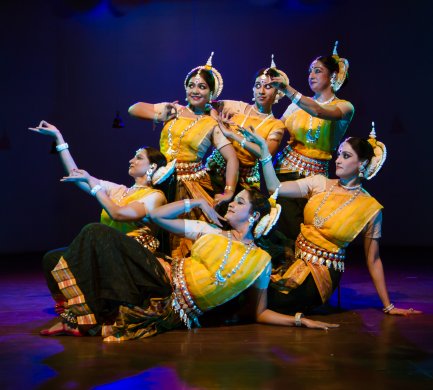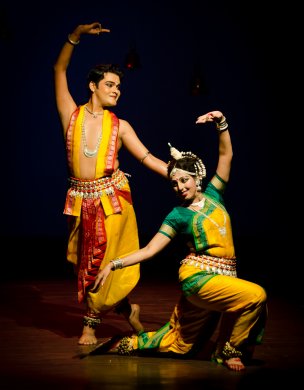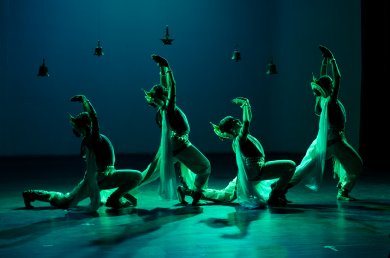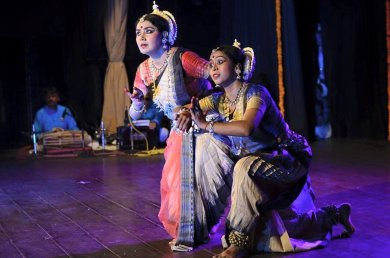
|   |

|   |
Sanjali’s Pravaha Festival - Poornima Gururaja e-mail: kalasindhudance@gmail.com Photos courtesy: Sanjali April 25, 2015 Sanjali Center for Odissi Dance and its director Sharmila Mukerjee hosted the Pravaha festival at Bangalore’s Seva Sadan on the 19th of April 2015. Sanjali mainly promotes Odissi form of classical dance and dancers. The first session was a series of presentations on the ‘Guru-Shishya parampara in the changing world of Indian classical dance.’ What was expected of the presentation were opinions on the challenges in transfer of knowledge and technique of classical dance through the traditional guru- shishya parampara, an oral tradition. Usha R.K. eloquently set the stage for the presentations. In her brief and well researched opening she defined the word guru, starting from the Upanishads (meaning to sit at one's feet), to a guru in the academic setting and a spiritual guru. She touched upon points a guru inculcates in students including qualities of humility, effacement and surrender. She talked about respect and commitment that a guru commands so much so that terms of superiority in addressing one’s guru are also defined. Lalitha Srinivasan, an exponent of the Mysore style of Bharatanatyam and a disciple of the legendary Venkatalakshamma, spoke with a focus on continuity of learning, and the limitations created by time and career demands on current practitioners of the art. In light of what Usha had said, Lalitha Srinivasan also seriously wondered whether instructors of dance in the current day and age were eligible to be called gurus. She also questioned the ability of teachers to retain a sustained interest level in the students after a certain level of training. She talked about how she had traversed beyond borders of what Kolar Kittappa or Mooguru Jejamma had to offer in terms of the Mysore style and learnt with guru Narmada to bring in a more definite emphasis on the nritta aspect of the dance. She acknowledged being inspired by the Odissi tradition with relation to ashtapadis. She added that although inspirations come from different ends, they only broaden your perspective. Tradition pertains to the land you come from and faith in the tradition is what sustains a tight frame work. The presentation of Ratikant Mohapatra was limited to his 40 year relationship with his mentor, guru and father, Odissi Guru Kelucharan Mohapatra. He stressed that the greatest thing he had learnt from his father was that a guru-shishya relationship is based on a give and take. He learnt from his father that a shishya can be a teacher too, and Kelubabu never hesitated to learn from his students. He threw light on a guru like Kelubabu being a keen observer of life. His insight on Kelubabu’s curiosity to learn human anatomy and physiology in order to correct a chowk position, or incorporate a sensual side movement, went to show that a guru is always open to learning and absorbing in order to create richness in his art. He also talked about Kelubabu’s relentless discipline and ability to teach according to the ability of a disciple. He taught through several decades, allowing for changes to occur fluidly across the years and demands of time. He incorporated tabla and mridangam bols into the playing of the mardala to heighten its richness. The concept of “I” was totally unacceptable to him. He always believed in a reciprocal relationship between the guru and the shishya. Senior critic and dance historian Dr. Sunil Kothari was quite emotional at the outset of his presentation. After someone who you have watched and interacted with passes on, your guru for example, losing that confidence of being able to approach someone to clarify, he questioned if it was enough to rely on memories of interaction with a guru to sustain as a teacher. He narrated the personal tragedies of a couple of dancers and spoke about how a guru inspired his student to live life. He stressed that a guru is not only a teacher of the art, but sometimes can be the lifeline of a student. Senior Odissi dancer and choreographer Aruna Mohanty spoke at the end of the two hour long presentation. She raised the issue of legacy or burden, when you learn under the shadow of greatness of the level of Kelucharan Mohapatra, and stressed on the fact that we have to believe strongly that it is a legacy, take care of it and pass it on as intact as we received it. We only have the freedom to layer over it if there is choice.  Sanjali ensemble  Argha Chatterjee and Arpita Venkatesh  Sanjali ensemble  Aruna Mohanty and Madhusmitha Mohanty After a short tea break, Pravaha went on to flood the audience with Odissi performances. The evening opened with a group presentation of the Sanjali ensemble. Clean footwork, confident young dancers presented a Yaman Pallavi choreographed by Sharmila Mukerjee. It was a pleasure to watch them move from formation to formation with ease and grace. The much talked about chowk of Sharmila's guru Kelucharan Mohapatra was evident in the presentation. Argha Chatterjee and Arpita Venkatesh from Kolkata presented a Pattadeep pallavi, a choreography of Guru Ratikant Mohapatra set to triputa taal. This was followed by an invocation to Durga that described the beauty and power of the goddess. The Gangashtakam of Shankaracharya by the Sanjali ensemble was apt choreography. It ended with a beautiful representation of the Gangarati. The black in the costume gave the impression of a partly polluted river. The concluding performances of the evening began with a presentation of Bhumi Suta by Aruna Mohanty. The following piece was a Rageshri Pallavi performed by Madhusmitha Mohanty. The duo presented an abhinaya piece based on the concept of naada or sound... its contextual meaning embodied the sound of the flute as heard by Yashoda, Radha and Meera. They were ably accompanied on the vocals by Rupak Kumar Parida, Bijaya Kumar Parida on the mardala, Agnimitra Behera on the violin and Srinibas Satapathy on the flute. Poornima Gururaja is the Director, Kalasindhu Academy of Dance and Related Arts, Bangalore. |